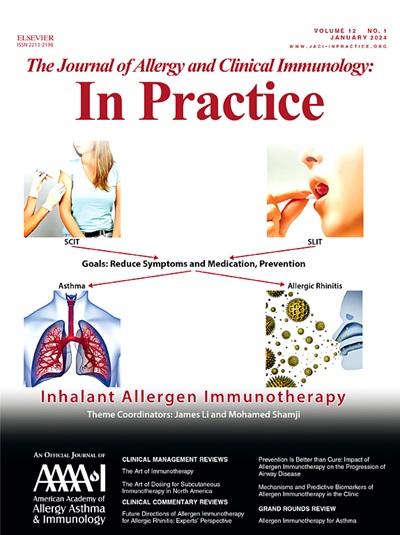Advancements in Novel Therapeutics for Chronic Spontaneous Urticaria
IF 6.6
1区 医学
Q1 ALLERGY
Journal of Allergy and Clinical Immunology-In Practice
Pub Date : 2025-09-01
DOI:10.1016/j.jaip.2025.05.035
引用次数: 0
Abstract
Chronic urticaria (CU) is defined by pruritic wheals with or without angioedema, associated with severe itch, which persist for greater than 6 weeks. Lesions move from one part of the body to another and generally are evanescent, lasting less than 24 hours. The global prevalence of the disease ranges from 0.5% to 5% and is correlated with an annual economic burden of over $200 million in the United States. Chronic urticaria can be further divided into chronic spontaneous urticaria and chronic inducible urticaria. Whereas chronic spontaneous urticaria has no identifiable trigger, chronic inducible urticaria can be provoked by both physical and nonphysical stimuli. As many as 7% to 30% of patients with CU can have both types. Mast cells are the major effector cells in the pathogenesis of CU. When activated, mast cells characteristically release bioactive mediators including histamine that bind to specific receptors causing vasodilation and extravasation of fluid from the blood vasculature. This causes the characteristic wheals and itch. However, the pathophysiology of CU is much more complex, involving many mast cell surface receptors, cytokines, and cell activation pathways that are targets for many of the currently available and investigational therapies. Studies have demonstrated that CU causes a significant amount of distress and disruption to patients’ daily lives that can be evaluated using validated patient-reported outcomes measures. In this review, we review CU epidemiology, pathophysiology, subtypes, and diagnosis and discuss current and novel therapies.
慢性自发性荨麻疹新疗法研究进展
慢性荨麻疹(Chronic urticaria, CU)的定义是瘙痒性皮疹伴或不伴血管性水肿,伴有严重瘙痒,持续6周以上。病变从身体的一部分转移到另一部分,通常是短暂的,持续时间不到24小时。该疾病的全球患病率在0.5% - 5%之间,与美国每年超过2亿美元的经济负担相关。慢性自发性荨麻疹又可分为慢性自发性荨麻疹(CSU)和慢性诱导性荨麻疹(CIndU)。CSU没有可识别的诱因,而CIndU可以由物理和非物理刺激引起。多达7 - 30%的CU患者可以同时患有这两种类型。肥大细胞是CU发病机制中的主要效应细胞。当被激活时,肥大细胞特征性地释放生物活性介质,包括与特定受体结合的组胺,引起血管舒张和血管外渗。这会引起典型的皮疹和瘙痒。然而,CU的病理生理学要复杂得多,涉及许多肥大细胞表面受体、细胞因子和细胞激活途径,这些途径是许多目前可用和正在研究的治疗方法的靶点。研究表明,CU对患者的日常生活造成了很大的困扰和干扰,可以使用经过验证的患者报告结果测量(PROMS)来评估。在这篇综述中,我们将回顾CU的流行病学、病理生理学、亚型和诊断,并讨论当前和新的治疗方法。
本文章由计算机程序翻译,如有差异,请以英文原文为准。
求助全文
约1分钟内获得全文
求助全文
来源期刊

Journal of Allergy and Clinical Immunology-In Practice
ALLERGYIMMUNOLOGY-IMMUNOLOGY
CiteScore
11.10
自引率
9.60%
发文量
683
审稿时长
50 days
期刊介绍:
JACI: In Practice is an official publication of the American Academy of Allergy, Asthma & Immunology (AAAAI). It is a companion title to The Journal of Allergy and Clinical Immunology, and it aims to provide timely clinical papers, case reports, and management recommendations to clinical allergists and other physicians dealing with allergic and immunologic diseases in their practice. The mission of JACI: In Practice is to offer valid and impactful information that supports evidence-based clinical decisions in the diagnosis and management of asthma, allergies, immunologic conditions, and related diseases.
This journal publishes articles on various conditions treated by allergist-immunologists, including food allergy, respiratory disorders (such as asthma, rhinitis, nasal polyps, sinusitis, cough, ABPA, and hypersensitivity pneumonitis), drug allergy, insect sting allergy, anaphylaxis, dermatologic disorders (such as atopic dermatitis, contact dermatitis, urticaria, angioedema, and HAE), immunodeficiency, autoinflammatory syndromes, eosinophilic disorders, and mast cell disorders.
The focus of the journal is on providing cutting-edge clinical information that practitioners can use in their everyday practice or to acquire new knowledge and skills for the benefit of their patients. However, mechanistic or translational studies without immediate or near future clinical relevance, as well as animal studies, are not within the scope of the journal.
 求助内容:
求助内容: 应助结果提醒方式:
应助结果提醒方式:


